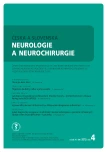The Importance of Vestibular and Posturographic Evaluation in Patients with Vestibular Schwannoma
Authors:
P. Kalitová 1,2; O. Čakrt 3; Z. Čada 1,4; O. Profant 1; Martin Chovanec 1,4; J. Betka 1; J. Jeřábek 5
Authors‘ workplace:
Klinika otorinolaryngologie a chirurgie hlavy a krku 1. LF UK a FN v Motole, Praha
1; Fyziologický ústav 1. LF UK v Praze
2; Klinika rehabilitace a tělovýchovného lékařství 2. LF UK a FN v Motole, Praha
3; Anatomický ústav 1. LF UK v Praze
4; Neurologická klinika 2. LF UK a FN v Motole, Praha
5
Published in:
Cesk Slov Neurol N 2013; 76/109(4): 469-474
Category:
Short Communication
Práce vznikla s podporou projektů UNCE 204013 a IGA MZČR NT/ 12459- 5. Děkujeme RNDr. Pavle Polechové za pomoc při statistickém zpracování dat.
Overview
Aim:
The aim of our study was to evaluate vestibular and posturographic findings in patients with vestibular schwannoma indicated for surgical removal. We focused particularly on evaluation of posturography.
Materials and methods:
The group consisted of 44 patients (19 women, 25 men) who underwent surgical removal of vestibular schwannoma at the Department of Otorhinolaryngology and Head and Neck Surgery, Faculty Hospital Motol, 1st Faculty of Medicine, Charles University, Prague between 2007 and 2010. Since all patients were indicated for surgery, the majority of the cohort were patients with the grade 4 disease (27). Before surgery, each patient underwent clinical vestibular examination, electronystagmographic recordings and posturography. The data were analysed using the independent sample T-test and cross-tabulations. A large number of variables were eliminated by factor analysis.
Results:
Statistical analysis revealed that the performance on the step quick turn test, a part of posturography, is the most typical parameter for vestibular pathology. Furthermore, we proved that younger age is associated with the presence of higher grade tumours.
Conclusions:
Our study confirmed the importance of posturography in the diagnosis of vestibular pathology in patients with vestibular schwannoma. Posturography should be added to electronystagmography as a standard diagnostic tool.
Key words:
vestibular schwanoma – electronystagmography – posturography – postural equilibrium
Sources
1. Betka J, Zvěřina E, Lisý J, Chovanec M, Kluh J, Kraus J.Vestibulární schwannom. Otorhinolaryng a Foniat 2008; 57(4): 221 – 225.
2. Zvěřina E. Neurinom akustiku – vestibulární schwanom – osobní pohled na nejmodernější postupy v jeho léčbě. Čas Lék Čes 2010; 149 : 269 – 276.
3. Komatsuzaki A. Nerve origin of the acoustic neuroma. J Laryngol Otol 2001; 115(5): 362 – 368.
4. Selesnick SH, Jackler RK, Pitts LW. The changing clinical presentation of acoustic tumors in the MRI era. Laryngoscope 1993; 103(4): 431 – 436.
5. Selesnick SH, Deora M, Drotman MB, Heier LA. Incidental discovery of acoustic neuromas. Otolaryngol Head Neck Surg 1999; 120(6): 815 – 818.
6. Anderson TD, Loevner LA, Bigelow DC, Mirza N. Prevalence of unsuspected acoustic neuroma found by magnetic resonance imaging. Otolaryngol Head Neck Surg 2000; 122(5): 643 – 646.
7. Eggers SD, Zee DS. Evaluating the Dizzy Patient: Bedside Examination and Laboratory Assessment of the Vestibular System. Semin Neurol 2003; 23(1): 47 – 58.
8. Čakrt O, Funda T, Černý R, Kolář P, Mužík J, Jeřábek J. Diagnosticky specifické nálezy při posturografickém vyšetření – dvě kazuistiky. Cesk Slov Neurol N 2012; 75/ 108(1): 88 – 91.
9. Furman JM, Baloh RW, Barin K, Hain TC, Herdman S,Horst RK. Assessment: posturography. Report of the Therapeutics and Technology Assessment Subcomittee of the American Academy of Neurology. Neurology 1993; 43(6): 1262 – 1264.
10. Cakrt O, Chovanec M, Funda T, Kalitová P, Betka J, Zverina E et al. Exercise with visual feedback improves postural stability after vestibular schwannoma surgery. Eur Arch Otorhinolaryngol 2010; 267(9): 1355 – 1360.
11. Beynon G, Jani P, Baguley DM. A clinical evaluation of head impulse testing. Clin Otolaryngol 1998; 23(2): 117 – 122.
12. Black RA, Halmagyi GM, Thurtell MJ, Todd MJ, Curthoys IS. The active head impulse test in Unilateral Peripheral vestibulopathy. Arch Neurol 2005; 62(2): 290 – 293.
13. Charabi S, Thomsen J, Tos M, Mantoni M, Charabi B, Juhler M et al. Management of intrameatal vestibular schwannoma. Acta Otolaryngol 1999; 119(7): 796 – 800.
14. Hempel JM, Hempel E, Wowra B, Schichor Ch, Muacevic A, Riederer A. Functional outcome after gamma knife treatment in vestibular schwannoma. Eur Arch Otorhinolaryngol 2006; 263(8): 714 – 718.
15. Wackym PA. Stereotactic radiosurgery, microsurgery and expectant management of acoustic neuroma: basis for informed consent. Otolaryngol Clin North Am 2005; 38(4): 653 – 670.
16. Wagner JN, Glaser M, Wowra B, Muacevic A, Goldbrunner R, Cnyrim C et al. Vestibular function and quality of life in vestibular schwannoma: does size matter? Front Neurol 2011; 2 : 55.
17. Day AS, Wang CT, Chen CN, Young YH. Correlating the cochleo vestibular deficits with tumor size of acoustic neuroma. Acta Otolaryngol 2008; 128(7): 756 – 760.
18. Shiffman F, Dancer J, Rothballer AB, Berett A, Baum S.The diagnosis and evaluation of acoustic neuromas. Otolaryngol Clin North Am 1973; 6(1): 189 – 228.
19. Matthies C, Samii M. Management of 1000 vestibulars chwannomas (acoustic neuromas): clinical presentation. Neurosurgery 1997; 40(1): 1 – 10.
20. Stangerup SE, Tos M, Caye ‑ Thomasen P, Tos T, Klokker M, Thomsen J. Increasing annual incidence of vestibular schwannoma and age at diagnosis. J LaryngolOtol 2004; 118(8): 622 – 627.
21. Borgmann H, Lenarz T, Lenarz M. Preoperative prediction of vestibular schwannoma‘s nerve of origin with posturography and electronystagmography. Acta Otolaryngol 2011; 131(5): 498 – 503.
22. Gouveris H, Helling K, Victor A, Mann W. Comparison of electronystagmography results with dynamic posturography findings in patients with vestibular schwannoma. Acta Otolaryngol 2007; 127(8): 839 – 842.
Labels
Paediatric neurology Neurosurgery NeurologyArticle was published in
Czech and Slovak Neurology and Neurosurgery

2013 Issue 4
Most read in this issue
- Difficulties Diagnosing Progressive Multifocal Leukoencephalopathy in Patients Infected with the Human Immunodeficiency Virus – Case Reports
- Skull Base Surgery
- Neuropsychiatric View of Huntington‘s Disease
- Validation of the Slovak version of the Movement Disorder Society – Unified Parkinson’s Disease Rating Scale (MDS‑ UPDRS)
